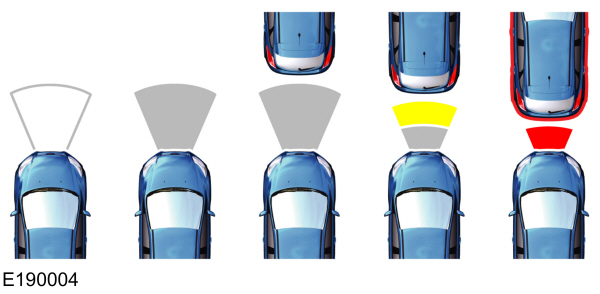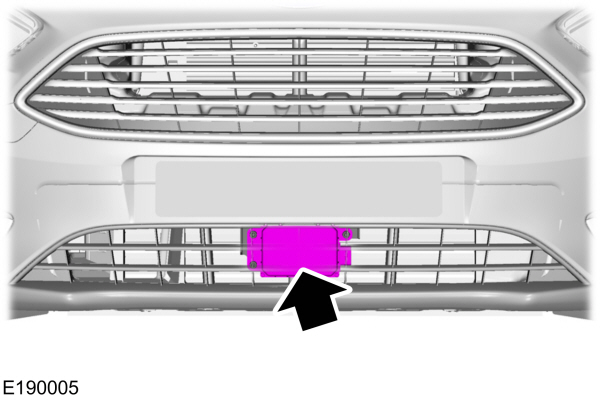This view of the Owner's Manual contains the very latest information, which may vary slightly from the printed Owner's Manual originally provided with your vehicle. It may also describe content that is not on or operates differently on your vehicle. Please consider the Owner's Manual originally provided with your vehicle as the primary source of information for your vehicle.

The information contained in this publication was correct at the time of release.In the interest of continuous development, we reserve the right to change specifications, design or equipment at any time without notice or obligation.No part of this publication may be reproduced, transmitted, stored in a retrieval system or translated into any language in any form by any means without our written permission.Errors and omissions excepted.
Copyright © 2024 Ford Motor Company
Collision Warning System (If Equipped)

 If the distance to the lead vehicle is small, the red warning lamp will illuminate in the instrument cluster.
If the distance to the lead vehicle is small, the red warning lamp will illuminate in the instrument cluster.

PRINCIPLE OF OPERATION
 WARNING:
This system is designed to be a supplementary driving aid. It is not intended to replace your attention, and judgment, or the need to apply the brakes. Failure to press the brake pedal to activate the brakes may result in a collision.
WARNING:
This system is designed to be a supplementary driving aid. It is not intended to replace your attention, and judgment, or the need to apply the brakes. Failure to press the brake pedal to activate the brakes may result in a collision. WARNING:
Never wait for a crash warning. When driving you are responsible for maintaining the correct distance and speed, even when the system is used.
WARNING:
Never wait for a crash warning. When driving you are responsible for maintaining the correct distance and speed, even when the system is used. |
Note:
The system does not detect, warn or respond to potential collisions with vehicles to the rear or sides of the vehicle.
Note:
The collision warning system is active at speeds above approximately
8 km/h (5 mph).

The system is designed to assist you by warning you of the risk of a crash with the vehicle in front of you. The system is designed to alert you by warning chimes and a visual warning in the information display.
The brake support system assists the driver in reducing the collision speed by charging the brakes. If the risk of collision further increases after the warning light illuminates, the brake support prepares the brake system for rapid braking. This may be apparent to the driver. Brake support may apply if the system determines that a collision is imminent. The system may help reduce impact damage or avoid the crash completely.
Using the Collision Warning System
 WARNING:
The collision warning system’s brake support can only help reduce the speed at which a collision occurs. The brake pedal must be pressed just like any typical braking situation.
WARNING:
The collision warning system’s brake support can only help reduce the speed at which a collision occurs. The brake pedal must be pressed just like any typical braking situation. |
Distance Alert
 If the distance to the lead vehicle is small, the red warning lamp will illuminate in the instrument cluster.
If the distance to the lead vehicle is small, the red warning lamp will illuminate in the instrument cluster.Note:
The warning lamp is small and below the Distance Indication graphic. It does not flash when Distance Alert is active.
Distance Indication
Distance Indication provides a graphical indication of the time gap to other vehicles traveling in the same direction. The information display will show one of the graphics below in color.

Key: Left to right.
Outline - Stand by.
Grey, no object - No object detected or object outside of Distance Indication range.
Grey, with object - Object detected or object within Distance Indication range.
Yellow, with object - Early Distance Indication warning threshold.
Red, with object - Final Distance Indication warning threshold.
Note:
Distance Alert and Distance Indication turns off when adaptive cruise control is switched on. The Distance Indication graphics do not display in the information display unless adaptive cruise control is switched off.
Adjusting Pre-Collision Assist Settings
If collision warnings are perceived as being too frequent, the warning sensitivity can be reduced, we recommend using the highest sensitivity setting where possible. Setting lower sensitivity would lead to fewer and later system warnings.
You can adjust the Collision Warning and Distance Alert sensitivity to one of three possible settings by using the information display control. You can also switch the Distance Indication function off using the information display controls. See
General Information.
Distance Alert sensitivity
| Speed | Sensitivity | Graphic | Distance gap | Time gap |
|---|---|---|---|---|
| 100 km/h (62 mph) | Normal | Grey | Greater than 25 m (82 ft) | Greater than 0.9 seconds |
| 100 km/h (62 mph) | Normal | Yellow | Between 17 m (56 ft) and 25 m (82 ft) | Between 0.6 and 0.9 seconds |
| 100 km/h (62 mph) | Normal | Red | Less than 17 m (56 ft) | Less than 0.6 seconds |
Blocked Sensors

The sensors are located at the center of the lower grille.
If a message regarding a blocked sensor appears in the information display, the radar signals from the sensor have been obstructed. When the sensors are obstructed, a vehicle ahead cannot be detected and the collision warning system does not function. The following table lists possible causes and actions for this message being displayed.
| Cause | Action |
|---|---|
| The surface of the radar in the grille is dirty or obstructed in some way | Clean the grille surface in front of the radar or remove the object causing the obstruction |
| The surface of the radar in the grille is clean but the message remains in the display | Wait a short time. It may take several minutes for the radar to detect that it is no longer obstructed |
| Heavy rain, spray, snow, or fog is interfering with the radar signals | The collision warning system is temporarily disabled. Collision warning should automatically reactivate a short time after the weather conditions improve |
| Swirling water, or snow or ice on the surface of the road may interfere with the radar signals | The collision warning system is temporarily disabled. Collision warning should automatically reactivate a short time after the weather conditions improve |
System Limitations
 WARNING:
The collision warning system’s brake support can only help reduce the speed at which a collision occurs. The brake pedal must be pressed just like any typical braking situation.
WARNING:
The collision warning system’s brake support can only help reduce the speed at which a collision occurs. The brake pedal must be pressed just like any typical braking situation. |
Due to the nature of radar technology, there may be certain instances where vehicles do not provide a collision warning. These include:
- Stationary vehicles or vehicles moving below 10 km/h (6 mph).
- Pedestrians or objects in the roadway.
- Oncoming vehicles in the same lane.
- Severe weather conditions (see blocked sensor section).
- Debris build-up on the grille near the headlamps (see blocked sensor section).
- Small distance to vehicle ahead.
- Steering wheel and pedal movements are large (very active driving style).
If the front end of the vehicle is hit or damaged, the radar sensing zone may be altered causing missed or false collision warnings. See your authorized dealer to have your collision warning radar checked for proper coverage and operation.
